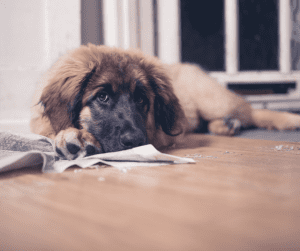Puppy Pads for House Training – Pros and Cons.
Lots of dog owners use puppy pads for house training and, in theory, they seem like a good idea. The puppy urinates on the absorbent pad, rather than your best rug. An ideal solution when you have a young puppy in the house, right? But what are the drawbacks, if any? Holidays4Dogs looks into the pros and cons of puppy pads when house-training a pooch.
There are always pro’s and con’s to everything and puppy training pads are no exception. On the one hand, they do have the potential to save carpets and soft furnishings from being soiled. However, conversely, they can create confusion for the puppy when it comes to house training.
House training woes.
It’s not uncommon for people who use training pads to become frustrated with their pup’s progress. The owner takes the pup outside to do his, or her, business. Then, once back indoors, immediately use the toilet pad. At other times, the puppy may urinate on rugs, carpets, bath mats etc. because to him, they are no different to the puppy training pads.
who use training pads to become frustrated with their pup’s progress. The owner takes the pup outside to do his, or her, business. Then, once back indoors, immediately use the toilet pad. At other times, the puppy may urinate on rugs, carpets, bath mats etc. because to him, they are no different to the puppy training pads.
Puppy house training mats can be useful in the very short term. For instance, if the pup has to be left in, or during night-time. However, there is the potential for pads to create confusion for the puppy. Some puppies may not grasp the concept of, where exactly they are supposed to go to the toilet.
Once the puppy is predominantly using the house pads, but is later ‘told off’ for using them, ( when the owner wants him to learn to go outside), the puppy may become even more nervous and confused.
Puppies are unable to control their bladder, or bowel movements completely, until they are around 16 weeks old. Therefore, absorbent pads are ideal for catching accidents.
They could also be useful for a dog that is ill, elderly, infirm, or incontinent. Pads are ideal for dogs that can’t get outside quick enough, or are unable to indicate they need to go out.
Best way to use puppy pads.
It is a good idea to place them as near to your exit door as possible. This way the puppy associates the training mat with the door to the outside. The more you place around the house, the more confusion you will create. And – another downside to potty training pads – lots of puppies will revel in ripping them into tiny pieces!
And – another downside to potty training pads – lots of puppies will revel in ripping them into tiny pieces!
Essentially, however, if you rely too long on puppy pads, you are simply creating an unnecessary extra step. I have known puppy owners that have been unable to wean their little four legged fellows off using pee pads, well beyond several months of age.
One might also consider the expense. Puppy training pads are not cheap and many are not great for the environment either. However, there are more eco-friendly ones on the market.
You can also buy puppy training trays, complete with two artificial grass pads, for indoor, or outdoor use. These may be useful if you want to train your dog not to use certain parts of the garden, or lawn.
For healthy puppies, the alternative to using puppy pads is to create a regular schedule. Feed your puppy at set times and take him out every time he has eaten, slept, or played. Generally speaking, for very young puppies a few weeks old, you will need to take them out every hour or so.
Conclusion.
By all means use puppy training pads in the early days, while both you and your puppy are building a routine. However, it is still imperative to keep taking your puppy outside at regular intervals. On balance, one could argue, you would be better investing in a decent mop and bucket and a few old towels.
Holidays4dogs.co.uk and 4Dogs are participants in the Amazon Services LLC Associates Program, an affiliate advertising program designed to provide a means for sites to earn commission fees by advertising and linking to the following websites. Read our full disclosure agreement here https://www.holidays4dogs.co.uk/affiliate-disclosure/


